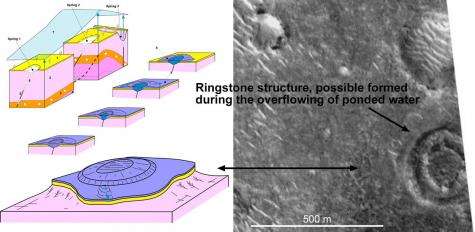Mars in Spain

A study coordinated by Universitat Autònoma Barcelona (UAB) on the origin and evolution of peculiar morphologies created by ancient subterranean springs in the central pre-Pyrenees of Catalonia (Spain) pose new questions for planetary geomorphology research. Similar to small volcanoes, these formations until now had only been described in Australia and closely resemble gigantic forms found on Mars. The study may shed new light on the origin of these formations and the search for water on the red planet.
In these past years a group of researchers from different universities and research centres, under the direction of Rogelio Linares, lecturer of the Department of Geology and researcher at UAB's Gabinet Geològic d'Anàlisi Territorial i Ambiental (GATA), carried out a geomorphological research in the Catalan pre-Pyrenees region. Part of the results of the study have been published in a special edition of the journal Geodinamica Acta. The publication, coordinated by some of the main specialists in Europe, corresponds to a selection of works presented at the European Geosciences Union General Assembly in Vienna in 2009.
This multidisciplinary research focuses on the study of geological records originated by ancient karstic springs. It specifically studies forms dating back over 250,000 years - tufa mounds - which are practically unknown in Europe, having been until now only described in Australia. Located in the Tremp Basin in Lleida, the formations are similar to volcanoes created by subterranean water springs, under specific hydraulic and hydrochemical conditions and in a certain geomorphological context.
One of the most relevant aspects of the research, and the one to generate most interest among the international scientific community, is the similarity between these types of "spring mounds" and the giant formations identified in various regions of Mars' surface. In the case of this study, the fact that these formations were generated by underwater cold springs makes it possible to consider that their "big sisters" on Mars could have a similar origin. The interest in this analogy is clearly linked to the search for water on the red planet.
Researcher Alexis Rodríguez, of the Planetary Science Institute in Tucson, Arizona and one of the world's experts in hydrogeological aspects on Mars, considers that the forms described and the formation models proposed by Rogelio Linares and collaborators are of great interest in the interpretation of the origin of geological formations recently detected on the surface of Mars.
For this reason, after a visit to the Tremp Basin, both researchers decided to work together on new studies with the aim of further investigating this peculiar Martian geomorphology found in Catalonia. The new research projects will include collaboration with other researchers from United States, Japan and China.
More information: Linares, R; Rosell, J; Roque, C; Gutierrez, F (2010). "Origin and evolution of tufa mounds related to artesian karstic springs in Isona area (Pyrenees, NE Spain)". Geodinamica Acta, 23/1-3: 129-150
Provided by Universitat Autonoma de Barcelona



















